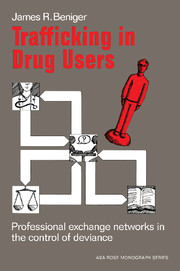Book contents
- Frontmatter
- Contents
- Acknowledgments
- Introduction
- 1 The emergence of the “drug problem”: social change versus social control
- 2 Control systems from exchange in networks: toward a synthesis of system and action theory
- 3 Stratification in information and referral exchange
- 4 Exchange relationships in social-control systems
- 5 The social system: boundary maintenance and hierarchical control
- 6 Summary: the control system in context
- Appendix A The data set
- Appendix B Subgroup sampling and estimated-density spaces (EDS)
- Notes
- Bibliography
- Name index
- Subject index
3 - Stratification in information and referral exchange
Published online by Cambridge University Press: 07 May 2010
- Frontmatter
- Contents
- Acknowledgments
- Introduction
- 1 The emergence of the “drug problem”: social change versus social control
- 2 Control systems from exchange in networks: toward a synthesis of system and action theory
- 3 Stratification in information and referral exchange
- 4 Exchange relationships in social-control systems
- 5 The social system: boundary maintenance and hierarchical control
- 6 Summary: the control system in context
- Appendix A The data set
- Appendix B Subgroup sampling and estimated-density spaces (EDS)
- Notes
- Bibliography
- Name index
- Subject index
Summary
Information and referrals convey opposite statuses in exchange relationships. This simple fact reconciles individual motivation, on the level of purposive action, with the prerequisites of control in the higher-level cybernetic system. With respect to the system, the relationship might be translated: The commodity controlled, and information about that commodity, convey opposite statuses to actors through exchange; information confers higher status on the provider, relative to the receiver, whereas commodity flow confers just the reverse statuses. Conversely, for any pair of actors differing in status, information and referrals are likely to move in opposite directions – information downward, referrals upward.
The importance of this fact for the community control of deviant drugusing youth was suggested in the previous chapter. In the informal drug community generated by professionals themselves through their exchange behavior, information is beneficial to give away, whereas referrals of young users (the commodity controlled by the system) are beneficial to receive. Certain formal positions can assure network centrality in local drug-abuse networks, but extra-organizational maneuvering can also secure centrality – and these informal roles may serve as criteria for later hiring in formal positions. Professionals will therefore attempt to establish themselves as information sources, whether formal or informal, and authority for deviants will readily pass (in the form of professional referrals) to specialists in central network positions.
- Type
- Chapter
- Information
- Trafficking in Drug UsersProfessional Exchange Networks in the Control of Deviance, pp. 56 - 92Publisher: Cambridge University PressPrint publication year: 1984



